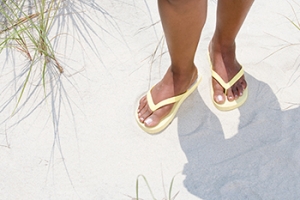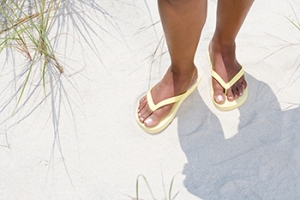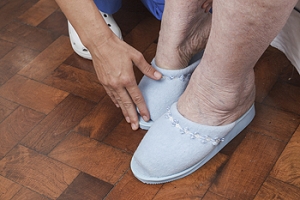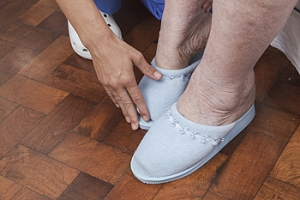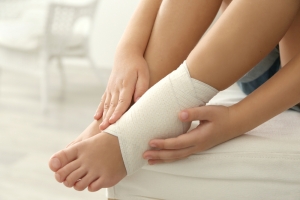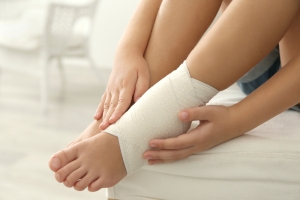Items filtered by date: January 2021
Why Live with Pain and Numbness in Your Feet?
Suffering from this type of pain? You may have the foot condition known as Morton's neuroma. Morton's neuroma may develop as a result of ill-fitting footwear and existing foot deformities. We can help.
Flip Flops May Damage Diabetic Feet
Flip flops are a type of shoe that is popular to wear during the summer months. There are a variety of styles and colors to choose from and they are simple to wear. Many people enjoy wearing flip flops, despite the fact these types of shoes have little or no arch support. Foot conditions may develop as a result of this, and can cause pain and discomfort. Diabetic patients in particular may be more susceptible to the negative effects of flip flops. Plantar fasciitis affects the heel and sole of the foot, and may gradually occur from wearing shoes that have inadequate arch support. Mild relief may be found when the bottom of the foot is stretched. This can be accomplished by standing on a step while gently lowering one heel at a time. Additionally, many patients find it beneficial to roll the sole of the foot on a tennis ball which is effective in stretching the plantar fascia. If you have questions about how flip flops can affect the feet, it is suggested that you confer with a podiatrist.
Flip-flops can cause a lot of problems for your feet. If you have any concerns about your feet or ankles, contact Dr. Kenneth Donovan from Advanced Care Foot and Ankle. Our doctor will assist you with all of your foot and ankle needs.
Flip-Flops and Feet
Flip-flops have managed to become a summer essential for a lot of people. While the shoes may be stylish and easy to slip on and off, they can be dangerous to those who wear them too often. These shoes might protect you from fungal infections such as athlete’s foot, but they can also give you foot pain and sprained ankles if you trip while wearing them.
When Are They Okay to Wear?
Flip-flops should only be worn for very short periods of time. They can help protect your feet in places that are crawling with fungi, such as gym locker rooms. Athlete’s foot and plantar warts are two common fungi that flip-flops may help protect your feet against.
Why Are They Bad for My Feet?
These shoes do not offer any arch support, so they are not ideal for everyday use. They also do not provide shock absorption or heel cushioning which can be problematic for your feet. Additionally, you may suffer from glass cuts, puncture wounds, and stubbed toes since they offer little protection for your feet.
More Reasons Why They Are Bad for Your Feet
- They Slow You Down
- May Cause Blisters and Calluses
- Expose Your Feet to Bacteria
If you have any questions, please feel free to contact one of our offices located in Warren, Livingston, and Toms River, NJ . We offer the newest diagnostic and treatment technologies for all your foot care needs.
Flip Flops May Damage Diabetic Feet
 Flip flops are a type of shoe that is popular to wear during the summer months. There are a variety of styles and colors to choose from and they are simple to wear. Many people enjoy wearing flip flops, despite the fact these types of shoes have little or no arch support. Foot conditions may develop as a result of this, and can cause pain and discomfort. Diabetic patients in particular may be more susceptible to the negative effects of flip flops. Plantar fasciitis affects the heel and sole of the foot, and may gradually occur from wearing shoes that have inadequate arch support. Mild relief may be found when the bottom of the foot is stretched. This can be accomplished by standing on a step while gently lowering one heel at a time. Additionally, many patients find it beneficial to roll the sole of the foot on a tennis ball which is effective in stretching the plantar fascia. If you have questions about how flip flops can affect the feet, it is suggested that you confer with a podiatrist.
Flip flops are a type of shoe that is popular to wear during the summer months. There are a variety of styles and colors to choose from and they are simple to wear. Many people enjoy wearing flip flops, despite the fact these types of shoes have little or no arch support. Foot conditions may develop as a result of this, and can cause pain and discomfort. Diabetic patients in particular may be more susceptible to the negative effects of flip flops. Plantar fasciitis affects the heel and sole of the foot, and may gradually occur from wearing shoes that have inadequate arch support. Mild relief may be found when the bottom of the foot is stretched. This can be accomplished by standing on a step while gently lowering one heel at a time. Additionally, many patients find it beneficial to roll the sole of the foot on a tennis ball which is effective in stretching the plantar fascia. If you have questions about how flip flops can affect the feet, it is suggested that you confer with a podiatrist.
Flip-flops can cause a lot of problems for your feet. If you have any concerns about your feet or ankles, contact Dr. Kenneth Donovan from Advanced Care Foot and Ankle. Our doctor will assist you with all of your foot and ankle needs.
Flip-Flops and Feet
Flip-flops have managed to become a summer essential for a lot of people. While the shoes may be stylish and easy to slip on and off, they can be dangerous to those who wear them too often. These shoes might protect you from fungal infections such as athlete’s foot, but they can also give you foot pain and sprained ankles if you trip while wearing them.
When Are They Okay to Wear?
Flip-flops should only be worn for very short periods of time. They can help protect your feet in places that are crawling with fungi, such as gym locker rooms. Athlete’s foot and plantar warts are two common fungi that flip-flops may help protect your feet against.
Why Are They Bad for My Feet?
These shoes do not offer any arch support, so they are not ideal for everyday use. They also do not provide shock absorption or heel cushioning which can be problematic for your feet. Additionally, you may suffer from glass cuts, puncture wounds, and stubbed toes since they offer little protection for your feet.
More Reasons Why They Are Bad for Your Feet
- They Slow You Down
- May Cause Blisters and Calluses
- Expose Your Feet to Bacteria
If you have any questions, please feel free to contact one of our offices located in Warren, Livingston, and Toms River, NJ . We offer the newest diagnostic and treatment technologies for all your foot care needs.
Techniques That May Help to Prevent Falling
Falling episodes among elderly people is a common occurrence worldwide. Many patients' feet are affected, and may endure a broken foot or sprained ankle as a result of an unexpected fall. Effective prevention techniques can consist of improving lighting in the household and getting regular physical examinations. Maintaining correct medications which may affect your vision can also reduce the risk of falling. Additionally, many patients find it is beneficial to install grab bars in the shower and toilet area, as this provides the necessary stability that can help to prevent falling. If you or a loved one is concerned about how falling can affect the feet, it is suggested that you speak with a podiatrist who can help you with proper prevention techniques.
Preventing falls among the elderly is very important. If you are older and have fallen or fear that you are prone to falling, consult with Dr. Kenneth Donovan from Advanced Care Foot and Ankle. Our doctor will assess your condition and provide you with quality advice and care.
Every 11 seconds, an elderly American is being treated in an emergency room for a fall related injury. Falls are the leading cause of head and hip injuries for those 65 and older. Due to decreases in strength, balance, senses, and lack of awareness, elderly persons are very susceptible to falling. Thankfully, there are a number of things older persons can do to prevent falls.
How to Prevent Falls
Some effective methods that older persons can do to prevent falls include:
- Enrolling in strength and balance exercise program to increase balance and strength
- Periodically having your sight and hearing checked
- Discuss any medications you have with a doctor to see if it increases the risk of falling
- Clearing the house of falling hazards and installing devices like grab bars and railings
- Utilizing a walker or cane
- Wearing shoes that provide good support and cushioning
- Talking to family members about falling and increasing awareness
Falling can be a traumatic and embarrassing experience for elderly persons; this can make them less willing to leave the house, and less willing to talk to someone about their fears of falling. Doing such things, however, will increase the likelihood of tripping or losing one’s balance. Knowing the causes of falling and how to prevent them is the best way to mitigate the risk of serious injury.
If you have any questions, please feel free to contact one of our offices located in Warren, Livingston, and Toms River, NJ . We offer the newest diagnostic and treatment technologies for all your foot care needs.
Techniques That May Help to Prevent Falling
 Falling episodes among elderly people is a common occurrence worldwide. Many patients' feet are affected, and may endure a broken foot or sprained ankle as a result of an unexpected fall. Effective prevention techniques can consist of improving lighting in the household and getting regular physical examinations. Maintaining correct medications which may affect your vision can also reduce the risk of falling. Additionally, many patients find it is beneficial to install grab bars in the shower and toilet area, as this provides the necessary stability that can help to prevent falling. If you or a loved one is concerned about how falling can affect the feet, it is suggested that you speak with a podiatrist who can help you with proper prevention techniques.
Falling episodes among elderly people is a common occurrence worldwide. Many patients' feet are affected, and may endure a broken foot or sprained ankle as a result of an unexpected fall. Effective prevention techniques can consist of improving lighting in the household and getting regular physical examinations. Maintaining correct medications which may affect your vision can also reduce the risk of falling. Additionally, many patients find it is beneficial to install grab bars in the shower and toilet area, as this provides the necessary stability that can help to prevent falling. If you or a loved one is concerned about how falling can affect the feet, it is suggested that you speak with a podiatrist who can help you with proper prevention techniques.
Preventing falls among the elderly is very important. If you are older and have fallen or fear that you are prone to falling, consult with Dr. Kenneth Donovan from Advanced Care Foot and Ankle. Our doctor will assess your condition and provide you with quality advice and care.
Every 11 seconds, an elderly American is being treated in an emergency room for a fall related injury. Falls are the leading cause of head and hip injuries for those 65 and older. Due to decreases in strength, balance, senses, and lack of awareness, elderly persons are very susceptible to falling. Thankfully, there are a number of things older persons can do to prevent falls.
How to Prevent Falls
Some effective methods that older persons can do to prevent falls include:
- Enrolling in strength and balance exercise program to increase balance and strength
- Periodically having your sight and hearing checked
- Discuss any medications you have with a doctor to see if it increases the risk of falling
- Clearing the house of falling hazards and installing devices like grab bars and railings
- Utilizing a walker or cane
- Wearing shoes that provide good support and cushioning
- Talking to family members about falling and increasing awareness
Falling can be a traumatic and embarrassing experience for elderly persons; this can make them less willing to leave the house, and less willing to talk to someone about their fears of falling. Doing such things, however, will increase the likelihood of tripping or losing one’s balance. Knowing the causes of falling and how to prevent them is the best way to mitigate the risk of serious injury.
If you have any questions, please feel free to contact one of our offices located in Warren, Livingston, and Toms River, NJ . We offer the newest diagnostic and treatment technologies for all your foot care needs.
Bones, Ligaments, and the Ankle Joint
Ankle sprains are a common ailment people may experience at one point in their life. Each foot consists of twenty-six bones, and three of these bones are located in the ankle joint. They are connected by numerous ligaments, and if they should become torn or overstretched, it may result in a sprained ankle. Common symptoms of this condition may consist of bruising and swelling, and it is often difficult to move the ankle. The ankle joint becomes unstable, and walking on the affected foot may cause severe pain and discomfort. The healing process often begins with elevating the foot, as this may reduce a portion of the swelling. Relief may be found when the sprained ankle is wrapped with an elastic bandage, which helps to limit mobility and provide the necessary stability as it heals. If you have sprained your ankle, please speak with a podiatrist as quickly as possible who can determine its severity, and guide you toward correct treatment choices.
Ankle sprains are common but need immediate attention. If you need your feet checked, contact Dr. Kenneth Donovan from Advanced Care Foot and Ankle. Our doctor can provide the care you need to keep you pain-free and on your feet.
How Does an Ankle Sprain Occur?
Ankle sprains take place when the ligaments in your ankle are torn or stretched beyond their limits. There are multiple ways that the ankle can become injured, including twisting or rolling over onto your ankle, putting undue stress on it, or causing trauma to the ankle itself.
What Are the Symptoms?
- Mild to moderate bruising
- Limited mobility
- Swelling
- Discoloration of the skin (depending on severity)
Preventing a Sprain
- Wearing appropriate shoes for the occasion
- Stretching before exercises and sports
- Knowing your limits
Treatment of a Sprain
Treatment of a sprain depends on the severity.
Many times, people are told to rest and remain off their feet completely, while others are given an air cast. If the sprain is very severe, surgery may be required.
If you have suffered an ankle sprain previously, you may want to consider additional support such as a brace and regular exercises to strengthen the ankle.
If you have any questions please feel free to contact one of our offices located in Warren, Livingston, and Toms River, NJ . We offer the newest diagnostic and treatment technologies for all your foot and ankle needs.
Bones, Ligaments, and the Ankle Joint
 Ankle sprains are a common ailment people may experience at one point in their life. Each foot consists of twenty-six bones, and three of these bones are located in the ankle joint. They are connected by numerous ligaments, and if they should become torn or overstretched, it may result in a sprained ankle. Common symptoms of this condition may consist of bruising and swelling, and it is often difficult to move the ankle. The ankle joint becomes unstable, and walking on the affected foot may cause severe pain and discomfort. The healing process often begins with elevating the foot, as this may reduce a portion of the swelling. Relief may be found when the sprained ankle is wrapped with an elastic bandage, which helps to limit mobility and provide the necessary stability as it heals. If you have sprained your ankle, please speak with a podiatrist as quickly as possible who can determine its severity, and guide you toward correct treatment choices.
Ankle sprains are a common ailment people may experience at one point in their life. Each foot consists of twenty-six bones, and three of these bones are located in the ankle joint. They are connected by numerous ligaments, and if they should become torn or overstretched, it may result in a sprained ankle. Common symptoms of this condition may consist of bruising and swelling, and it is often difficult to move the ankle. The ankle joint becomes unstable, and walking on the affected foot may cause severe pain and discomfort. The healing process often begins with elevating the foot, as this may reduce a portion of the swelling. Relief may be found when the sprained ankle is wrapped with an elastic bandage, which helps to limit mobility and provide the necessary stability as it heals. If you have sprained your ankle, please speak with a podiatrist as quickly as possible who can determine its severity, and guide you toward correct treatment choices.
Ankle sprains are common but need immediate attention. If you need your feet checked, contact Dr. Kenneth Donovan from Advanced Care Foot and Ankle. Our doctor can provide the care you need to keep you pain-free and on your feet.
How Does an Ankle Sprain Occur?
Ankle sprains take place when the ligaments in your ankle are torn or stretched beyond their limits. There are multiple ways that the ankle can become injured, including twisting or rolling over onto your ankle, putting undue stress on it, or causing trauma to the ankle itself.
What Are the Symptoms?
- Mild to moderate bruising
- Limited mobility
- Swelling
- Discoloration of the skin (depending on severity)
Preventing a Sprain
- Wearing appropriate shoes for the occasion
- Stretching before exercises and sports
- Knowing your limits
Treatment of a Sprain
Treatment of a sprain depends on the severity. Many times, people are told to rest and remain off their feet completely, while others are given an air cast. If the sprain is very severe, surgery may be required.
If you have suffered an ankle sprain previously, you may want to consider additional support such as a brace and regular exercises to strengthen the ankle.
If you have any questions please feel free to contact one of our offices located in Warren, Livingston, and Toms River, NJ . We offer the newest diagnostic and treatment technologies for all your foot and ankle needs.
Plantar Warts Can Be Treated!
Plantar warts are small growths that develop on parts of the feet that bear weight. They're typically found on the bottom of the foot. Don't live with plantar warts, and call us today!



